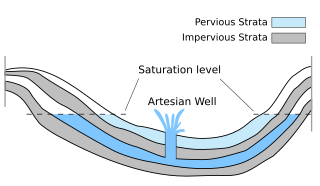
Jinan, formerly romanized as Tsinan, is the capital of Shandong province in Eastern China. The area of present-day Jinan has played an important role in the history of the region from the earliest beginnings of civilization and has evolved into a major national administrative, economic, and transportation hub. The city has held sub-provincial administrative status since 1994. Jinan is often called the "Spring City" for its famous 72 artesian springs. Its population was 6.8 million at the 2010 census.
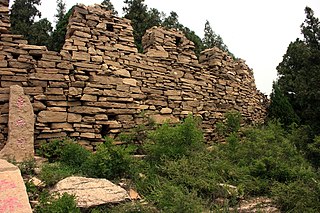
The Great Wall of Qi is the oldest existing Great Wall in China. Construction of the wall started in 685 BC by the state of Qi, to defend itself from southern states of Ju and Lu and later on, from the Kingdom of Chu. The existing sections date back to 500 BC. Construction ended during the Warring States period. The wall stretches from the areas under the administration of the present-day city of Jinan to the present-day city of Qingdao across the territories of the present-day cities of Tai'an, Zibo, Laiwu, Weifang, Linyi, and Rizhao. Its total length has been estimated at about 600 kilometers. Most of the wall is still able to be seen.

The Baotu Spring is a culturally significant artesian karst spring located in the city of Jinan, Shandong, China. It is mentioned in the Spring and Autumn Annals, one of the Five Classics of Chinese literature, and was declared the "Number One Spring under the Heaven" by the Qianlong Emperor in the Qing dynasty.

Hua Hill (Shandong) is a solitary cone-shaped hill in the lower Yellow River valley, located at the northeastern edge of the city of Jinan, Shandong Province, China. The hill is known for its cultural and historical significance as well as for its natural environment. It has been an inspiration for Chinese artists for many centuries and was the site of the Battle of An, a major battle fought during the Spring and Autumn period.

The Baimai Springs are a group of artesian karst springs located in Mingshui Subdistrict, Zhangqiu District, Jinan, Shandong Province, China about 25 kilometres west from the city centre of Jinan. The site of the springs is renowned for its natural beauty and as the one-time residence of the female Song Dynasty poet Li Qingzhao.
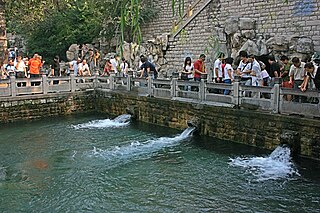
The Black Tiger Spring (Chinese: 黑虎泉; pinyin: Hēi Hǔ Quán) is a culturally significant artesian karst spring located in the city of Jinan, Shandong Province, China. The spring is ranked as the second most significant among the 72 named springs in Jinan. The water of spring stems from moderately-deep circulation and emerges from a water-filled limestone cave in a steep cliff. From the mouth of the cave, the water is funneled to flow out of the mouths of three ornamental stone-carved tiger heads into a square-shaped spring pool. From there it runs into the old city moat, next to which the spring is located. According to the tradition, there was a black rock lying in front of the cave in ancient time. The name of the spring is said to be derived from the shape and color of the rock, which resembled a black tiger, and the sound of the water gushing past the rock being reminiscent of the roar of a tiger. The ancient layout of the spring is described in a poem by the Ming Dynasty poet, Yan Bizeng.

The Five Dragon Pool is a culturally significant pond fed by artesian karst springs in the city of Jinan, Shandong Province, China. It is one of the best known springs among the 72 famous springs of Jinan.

The Five Lotus Spring is an artesian karst spring located in the city of Jinan, Shandong Province, China. The spring is located in the old city moat to the southeast of the historical city centre. A spring pool with a water level above that of the moat is formed by an arrangement of natural rocks.
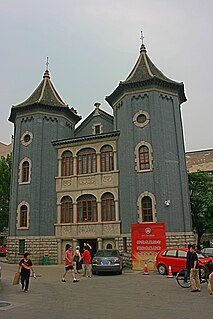
The Republican Building (Chinese: 共和楼; pinyin: Gòng He Lóu) is a historical landmark building, a hospital from the early 20th century located at the Shandong University campus, in the city of Jinan, Shandong Province, China. The building was originally part of the hospital of Cheeloo University. Construction was sponsored by the British Baptist Church. Work began in 1914 and was completed the following year. The building was officially inaugurated on September 27, 1915 by the military governor of Shandong, Jin Yunpeng.
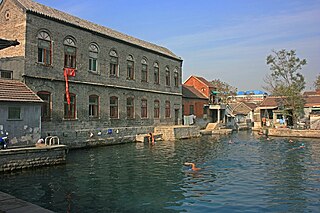
The Zhuoying Spring is a culturally significant artesian karst spring located in historical center of the city of Jinan, Shandong Province, China. It is listed among the 72 famous springs (Chinese: 七十二名泉; pinyin: Qīshíèr Míng Quán) of Jinan. The spring forms a large spring pool, the Palace Pool, that is used as a public outdoor swimming pool.

The Zhejiang and Fujian Meeting Hall (Chinese: 浙闽会馆; pinyin: Zhèmǐn Huìguǎn) is a historical Qing- Dynasty building in the City of Jinan, Shandong Province, China. It served as a meeting hall for traders form Zhejiang and Fujian living in Jinan and is the last remaining structure of its kind in the city. It illustrates the importance of Jinan as a trading center in the second half of the 19th century.

The Cassock Spring, also called Dugu Spring or Yinquan Spring, is a culturally significant artesian karst spring on the grounds of the Lingyan Temple in the city of Jinan, Shandong Province, China. The name Cassock Spring refers to a piece of cast iron that is positioned at the edge of the spring pool and resembles a cassock. The Cassock Spring is listed among the "seventy-two famous springs", a list of springs in Jinan that has been kept and updated since the times of the Jin, Ming, and Qing Dynasties.

The Guangzhi Yuan is a historical building in the City of Jinan, Shandong Province, China. In the early 20th century, it housed a museum that became the forerunner of the Shandong Provincial Museum.

Qushuiting Street (Chinese: 曲水亭街; pinyin: Qūshuǐtíng Jiē; literally: 'Winding water pavilion street' is a culturally significant alley in the historical center of the City of Jinan, Shandong Province, China. The history of the street can be traced back to the times of the Northern Wei Dynasty.

Laiwu is one of ten districts of the city of Jinan, Shandong province, China.

The Guandi Temple on Communist Youth League Street is a historical temple dedicated to Guan Yu in the Tianqiao district of Jinan, Shandong Province, China. It is one of the three best-preserved Guanyu temples in the area of Jinan, the other two are Guandi Temple in the Water Lily Street and in Xianxi Alley (县西巷).
The Kuixu Library is a historical building of the Shandong Provincial Library in Jinan, the capital of Shandong Province, China.
The Ming Hu Ju is a theater that features primarily traditional performing arts from Shandong. It is located on the southern shore of the Daming Lake and to the north of the historical center of the city of Jinan, Shandong, China. The theater has been in operation since the late Qing dynasty. It was established in 1890 and its founding is attributed to the local artist Guo Dani (郭大妮). Besides the theater proper, the Ming Hu Ju also functions as a tea house and a restaurant. The Ming Hu Ju is featured as a setting in the novel The Travels of Lao Can by Liu E.



